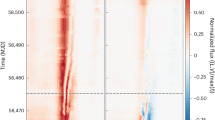Abstract
The new information regarding the absorption of high energy photons and electrons, presented at the recent International Congress on Nuclear Physics, suggests an improved interpretation of certain cosmic ray phenomena. Three distinct components of cosmic rays have been recognised. Eckart's analysis1 of the depth v. ionisation data shows clearly the presence of two components in the cosmic rays which reach the earth's surface. These components have mean absorption coefficients of about 0·6 and 0·06 respectively per metre of water. Gross2 and Compton and Stephenson3 find that the high altitude data from stratosphere balloons also indicate the presence of two components, the more penetrating of which is probably identical with Eckart's less penetrating component. Let us call these components A, B and C in the order of their penetrating power.
This is a preview of subscription content, access via your institution
Access options
Subscribe to this journal
Receive 51 print issues and online access
$199.00 per year
only $3.90 per issue
Buy this article
- Purchase on Springer Link
- Instant access to full article PDF
Prices may be subject to local taxes which are calculated during checkout
Similar content being viewed by others
References
C. Eckart, Phys. Rev., 45, 851 ; 1934.
B. Gross, Z. Phys., 83, 217 ; 1933.
A. H. Compton and R. J. Stephenson, 45, 441 ; 1934.
Author information
Authors and Affiliations
Rights and permissions
About this article
Cite this article
COMPTON, A., BETHE, H. Composition of Cosmic Rays. Nature 134, 734–735 (1934). https://doi.org/10.1038/134734b0
Issue Date:
DOI: https://doi.org/10.1038/134734b0
This article is cited by
-
Cosmic Ray Particles of High Penetrating Power
Nature (1936)
-
Raman Spectra of Deuterobenzenes and the Structure of Benzene
Nature (1935)
Comments
By submitting a comment you agree to abide by our Terms and Community Guidelines. If you find something abusive or that does not comply with our terms or guidelines please flag it as inappropriate.



